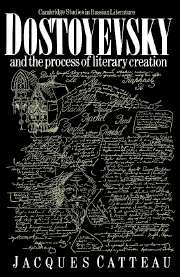Book contents
- Frontmatter
- Contents
- Preface to the English edition
- List of abbreviations
- General editor's note on transliteration and references
- General introduction
- PART I The creative environment
- PART II The process of creation
- Part III Time and space in the world of the novels
- Introduction
- 19 The master of men and hours
- 20 Chronology and temporality in The Idiot
- 21 The ascending spiral
- 22 Time of power and power of time
- 23 The havens of eternity
- 24 The dream of space and the space of the real
- 25 The inventory and the expressionist orchestration of scenery and lighting
- 26 The semantics of colour
- 27 The hero in space: sighting and seeing
- Conclusion
- Notes
- Select bibliography
- Index of names
23 - The havens of eternity
Published online by Cambridge University Press: 18 December 2009
- Frontmatter
- Contents
- Preface to the English edition
- List of abbreviations
- General editor's note on transliteration and references
- General introduction
- PART I The creative environment
- PART II The process of creation
- Part III Time and space in the world of the novels
- Introduction
- 19 The master of men and hours
- 20 Chronology and temporality in The Idiot
- 21 The ascending spiral
- 22 Time of power and power of time
- 23 The havens of eternity
- 24 The dream of space and the space of the real
- 25 The inventory and the expressionist orchestration of scenery and lighting
- 26 The semantics of colour
- 27 The hero in space: sighting and seeing
- Conclusion
- Notes
- Select bibliography
- Index of names
Summary
What is time? Time does not exist: time is numbers, time is the relationship of being to non-being.
F. M. Dostoyevsky, Notebooks for Crime and PunishmentDostoyevsky kneads time like bread, accelerating and contracting it and stuffing it with a thousand events and possibilities, but his sense of reality forbids him to abolish it. However, at the heart of the time of power, the hero catches a glimpse of freedom. In his desire for complete freedom, he breaks through the forbidden doors: the door of real time and the door of suffering, which, as Dostoyevsky repeats throughout his work, is the only way of reaching happiness. The hero plunges into eternity and sees, as in the Book of Revelation, that there should be time no longer. At these instants, Dostoyevsky allows his heroes, exhausted by their painful freedom, a moment of rest to quench their thirst at the spring which he forbids himself to use as a novelist, although he had tasted it as a man.
The experience of eternity
It was a bitter privilege, since Dostoyevsky owed his knowledge of eternity to two terrible experiences which seldom occur together in one human life: the death sentence and epilepsy.
Epilepsy brought him, beyond faith, the sure conviction that eternity exists, that it is indescribable happiness, where the freedom of the creature is serenely at one with the harmony of the universe; epilepsy also gave him the marvellous power of experiencing eternity. Dostoyevsky generously extended this certainty and power to some of his heroes who were epileptic, such as Myshkin, and also to some who were not, such as Kirillov.
- Type
- Chapter
- Information
- Dostoyevsky and the Process of Literary Creation , pp. 372 - 381Publisher: Cambridge University PressPrint publication year: 1989



